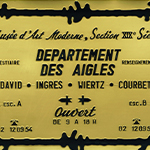The solo exhibition by the Berlin-based international collective Slavs and Ta-tars takes its title from Simurgh, a majestic, mythological bird-like creature with references to Persianate, Turkic, and other Eurasian histories. The Si-murgh story, rich in themes of unity and the interconnectedness of all living beings, offers important insights into the idea of coexistence and its relation to democracy, representational politics, self-governance, and the construction of hope. Through various media – from sound to glasswork, textiles to mirrors – Simurgh invites us to engage in a conversation on existence, living together, and belonging, transforming the Staatliche Kunsthalle Baden-Baden into a space for self-discovery and conviviality.
Simurgh includes newly commissioned works that connect this Eurasian crea-ture to the context of Baden-Baden and Baden-Württemberg through the tra-dition of living, regenerating tales, fables, and mythologies, such as those of the Black Forest. Selected works by the pioneering conceptual artist Marcel Broodthaers (1924–1976) will feature in the exhibition promenade as referen-tial forms, alongside a sound-based installation by Istanbul-based artist Cevdet Erek. These elements extend the horizons of Simurgh symbolically, ar-chitecturally and sonically.
The artists aim to build upon Broodthaers’ seminal work Musée d’Art Moderne: Département des Aigles (1968–71) – where the role of the eagle in French and German heraldry, literature, and history is deconstructed – by replacing the eagle, a nationalist symbol, with the Simurgh, a figure that is decidedly trans-national, if not metaphysical.
As part of their collective and discursive artistic practice, Slavs and Tatars have invited Cevdet Erek to collaborate on a joint exhibit as part of the prom-enade – at the main space of the Kunsthalle. Adapting an earlier piece, origi-nally presented outdoors, Courtyard Ornamentation with Four Sounding Dots and a Fake Shade (2024) Erek fosters a contemplation of rhythm by highlight-ing the connections between sound patterns featuring rhythmic repetitions. His work focuses on these auditory elements as well as the visual and spatial aspects traditionally associated with architectural ‘ornamentation’.
Slavs and Tatars have long been more interested in the peripheries of knowledge production, the edges of belief systems, and the margins of rituals rather than the centers; for it is at these borders where syncretism and hy-bridity thrive. Since its inception in 2006, the collective has shown a keen grasp of polemical issues in society, clearing new paths for contemporary dis-course via a wholly idiosyncratic form of knowledge production: including popular culture, spiritual and esoteric traditions, oral histories, modern myths, as well as scholarly research.
Since the fall of the USSR and especially since the full-scale Russian invasion of Ukraine, there’s been an important drive amongst former Soviet peoples towards articulating national identity and agency away from the top-down, colonial influence of Moscow. However, it is equally crucial today to also acti-vate and redeem that which unites us as much as that which distinguishes us. These regional solidarities can be folkloric, spiritual, and semiotic (such as the Simurgh), or culinary (as the collective’s interest in pickles and fermentation has shown), or ritualistic (be they harvest festivals or drinking tea from a sam-ovar, both of which feature in their work). By focusing on the various itera-tions of a mythical and metaphysical symbol across a wide region, Simurgh reimagines the regionalism which lies at the very core of Slavs and Tatars’ ar-tistic practice.
The reach of this otherworldly bird extends from today’s central Ukraine (Semargl, one of the nine pagan gods of pre-Christian Kyivan Rus’) to the Ui-ghur region in present day China. It is fitting then, that one of the most promi-nent allegories of the Simurgh is the Sufi notion of finding oneness in multi-plicity. In Farid ud-Din Attar’s (1145–1221) The Conference of the Birds, sev-eral birds embark on a long journey to find their leader, the legendary Si-murgh, only to discover in the end that God or the Transcendent resides within themselves.
The curatorial frame of the exhibition is inspired by this 12th century epic where the Simurgh serves as a narrative device. To reach Mount Qaf, the birds must pass through seven valleys: the Valleys of Will, Love, Ignorance, Doubt, Loneliness, Rumors, and finally the Valley of Self. The exhibition is conceived in alignment with this story, juxtaposing earlier works by Slavs and Tatars with the new Simurgh-themed works.
Simurgh (2025) is commissioned by the Staatliche Kunsthalle Baden-Baden, Germany, and the Frac des Pays de la Loire, Nantes, France. The exhibition will be presented for the first time as a major solo show in both institutions: at the Staatliche Kunsthalle Baden-Baden from February 14 to May 18, 2025, fol-lowed by an exhibition at Frac des Pays de la Loire in Summer 2025.
The exhibition at the Staatlichen Kunsthalle Baden-Baden is curated by Çağla Ilk, Misal Adnan Yıldız und Sandeep Sodhi.
Press release from Staatliche Kunsthalle Baden-Baden
Image: Marcel Broodthaers. Département des Aigles (David-Ingres-Wiertz-Courbet)(goldversion). 1968. vacuum-formed plastic (framed). 80 x 120 cm.
Image courtesy of Marcel Broodthaers estate.



